| |
Lee
Fullarton
Australia
31st October 2014-12th December 2014
The initial works of the artist include sketches, prints, observations
and journal works of personal responses to the museums and surrounds
of Sanskriti that resonate with the artist. This begins the process
for development of ideas and concepts that will be composed into larger
works that will be completed during 2015.
|

|
Miranda
Free
Australia
31st October 2014-12th December 2014
Miranda Free is a representational artist who comes from Perth Australia.
While residing at Sanskriti she is developing works that are about differing
roles that women choose for their lives - she will undertake drawings,
painted studies of people, backgrounds and objects that are significant
for the subjects. She will collage these images to develop large works
in oils and plans three while here - Lee (a collaborating artist colleague)
as Art Warrior, Sangita who works in Sanskriti office, and an Indian
village woman who cooks at Sanskriti.
|
| |
Jarred
Pruis
Helpman Academy Artists
Australia
17th October 2014 – 30th November 2014 Jarred Pruis
“I work mostly in clay. Spending time in India I have began to
investigate traditional Indian art and art practices, the ritual object,
myth and spirituality whilst drawing from dreams and imaginings.”
|

|
Genevieve
Dawson-Scott
Helpman Academy Artists
Australia
17th October 2014 – 30th November 2014
Genevieve Dawson-Scott is an emerging artist interested in the relationships
between ‘prayer and play’, ‘meditation and making’.
In her work during the Sanskriti Residency she continues to explore
ideas of how an artwork or object may embody a sense of spirit, and
possess power.
|
| |
Lucy
Palmer
Helpman Academy Artists
Australia
17th October 2014 – 30th November 2014
The horizon implies the infinite. It divides and it holds together.
It is a seam, separating earth and sky, material and immaterial. An
uninterrupted, continuous horizon gives a sense of the ineffable, the
infinite and the utterly incredible potential of distance and space.
This vast emptiness offers the mind the freedom to escape. Here is where
the distinction between self and space blur.
“Through the medium of glass, I investigate the relationship between
vast, open spaces and the mind. India is the stark opposite to the environment
explained above. Overcrowded, dense, bright, noisy and cluttered. Here
a person is granted no space. Some thrive in these environments, the
big cities, the speed, the thrills, the constant excitement. Colour
exploding from every corner. Fireworks, street parties, horns and never
ending drama… I love this too, but for me, being here has intensified
the appreciation I have for the choice of space. The space I am granted
in Australia, where I can chose to switch all of this off and inhabit
a space where from one horizon to the other, there is just me…
Since arriving here I have learnt a lot about myself and my need for
space; physical, emotional and mental. It has become very obvious why
meditation and mindfulness practices are so valued, as these are important
tools in achieving a clear mental space in such a crowded space. To
remove the physicality is to remove the chaos. I learn more about this
each day…”
|

|
Nick
Hanisch
Helpman Academy Artists
Australia
17th October 2014 – 30th November 2014
My works are investigations of narrative tropes and imaginary worlds.
Currently I am fascinated by the combined mash of old and new in the
Indian landscape. The way ancient architecture is bandaged with hi tech
satellites and electronics. Holy symbols of every religion hang next
to Vodafone advertising. Cows graze in front of a Lamborghini shop.
This constant clashing reminds me of dystopian fictions of a society
rebuilding where it's habitations merge with the natural landscape.
|
.JPG)
|
Vicki
McConville
Australia
28th September 2014 – 27th November 2014
Vicki McConville works with print, projections, constructions and sound.
Her work investigates trade, travel and the transformation of images
and ideas. As a PhD (Studio Research) candidate, she has been an Artist
in Resident in Venice, Istanbul, Beijing and Delhi. She is currently
a Prime Minister’s Australia-Asia Award Scholar. |
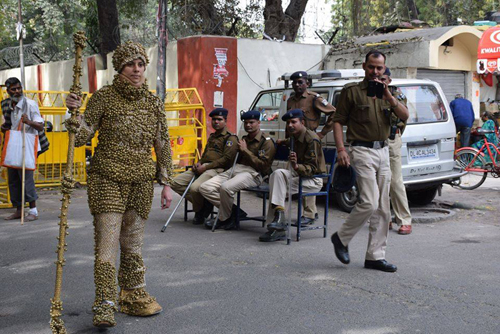
|
Amanda
Melo da Mota
Brazil
5th Dec. 2014 - 5th Feb. 2015
Amanda was sponsored by the Embassy of Brazil and is the second artist
to visit Sanskriti. As a visual artist she does photography, sculpture
and videography. Her project at Sanskriti revolved around “Confinement”.
She visited local artists living in far flung pockets of Delhi to learn
the folk arts and visited the potters colony to enrich her knowledge
about terracotta. She learnt massage therapy as part of her project
in India and developed a series of terracotta hearts as headgears. She
was inspired by the old city of Delhi and worked with old and used things
to include in her project. She did a public project at Jantar Mantar,
New Delhi, dressed in an outfit made of “Ghungroo” during
the protest staged by Delhi Govt. against Center Govt.’s Land
Acquisition Bill. A She went for Vipasna for meditation. |
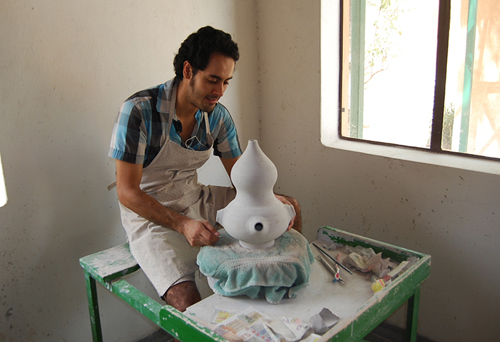
|
Leonardo
Sanchez
Colombia
During my stay at Sanskriti I worked on the Modular Light Projector.
I designed an interactive modular object to project light from inside.
The light is projected through four modules with orifices on it. These
modules can be rotated horizontally modifying the direction of the light
and changing the appearance of the object. The inspiration for the same
came from the importance of lamps and masks in India especially during
the festivals and religious rituals. Lamps are important in lighting
homes and masks represent the Indian folklore full of myths and legends
that are an integral part of the culture. |

|
Julie
Wayne
France
Julie Wayne is a photographer from France who has spent over a decade
researching and photographing the ritual practices of the ancient cult
of Ayyanar in Tamil Nadu. Sanskriti Foundation and Indira Gandhi National
Centre for Arts collaborated in bringing together her work and organized
an exhibition titled "From Earth to Earth" of over 100 photographs
and live demonstrations at IGNCA which also saw a lecture by Prof. Gautam
Sengupta and later the exhibition opened at Sanskriti Foundation with
a Symposium organized on 'The Art of Terracotta in India: Historical
and Living Traditions'.
|
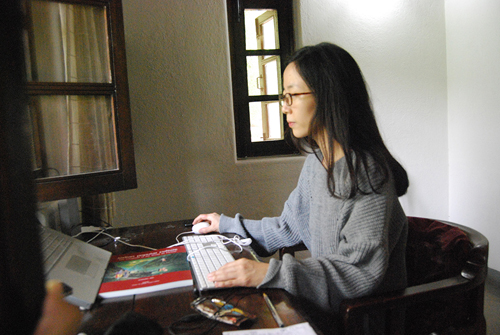
|
Yuni
Kwon
Republic of Korea
31st October 2014 – 31st December 2014
Yuni Kwon takes an interdisciplinary approach to her practice as an
artist by constructing a bridge between personal, social and natural
phenomena. Using a variety of media, such as video, data visualizations
and site-specific installation, she creates an imaginary relationship
between humans and nature, both together as well as separately. Based
on the proposition that structure of nature and human spirit are connected
with each other by mirror symmetry that is over individual asymmetry,
the extensive meanings of the nature in humans and Nature and the relation
between them are suggested through works. In the work, the state of
the mind can be imagined, by considering the complexity of the mind
and comparing it with natural phenomena. Digital media is one way of
developing a beyond physical relationship with nature. Kwon creates
a virtual environment that re-experiences nature by particular perspectives,
transcending the sense of coexistence. Yuni Kwon has been awarded with
the UNESCO-Aschberg Bursary for Artists (2014) at Sanskriti Foundation,
India. |
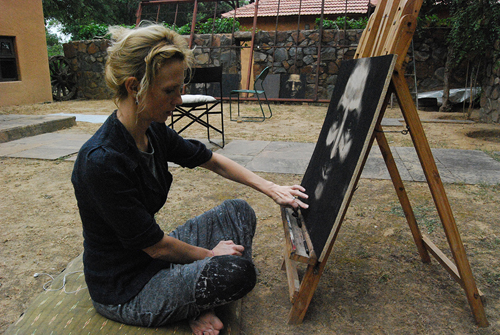
|
Ausra
Kleizaite
Lithuania
8th October 2014-30th October 2014
“I am showing three pieces of the series of drawings named “
Om WIND w “. This time it had happened like this that I am paying
tribute to the people, who impressed, influenced, affected and touched
my soul. In a visual way the serie is based on a portrait as a window
to the world and as a window to the world of soul and spirit of a man.
As it is going to happen that the series will consist of the drawings
of people from India and people from Lithuania there is a thought about
the identity too.” |
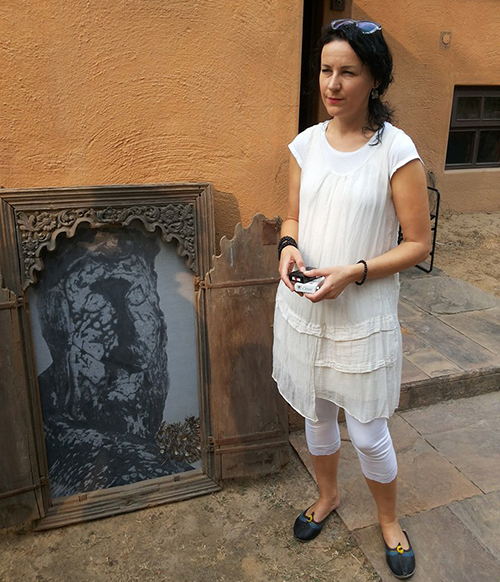
|
Monika
Zaltauskaite
Lithuania
8th October 2014-30th October 2014
“Care Sheet” Embroidery, jacquard weaving, wooden frame,
rusts, nails.
The artwork is based on a story about a burnt out church in Lithuania,
the building fell, and only the sculpture of Jesus remained. I took
a picture of his face and transformed it, weaved it in fabric. I found
old frame in Sanskriti and installed this fabric into it with the thoughts
of a new altar. The artwork “Care sheet” is like a sheet,
which is vestured and protected. Textile and fabric for this reason
is so important. Embroidery with the old nails and found objects in
Sanskriti will become like time marks which were left and rust will
go to the fabric deeper and deeper. |

|
Ricardo
Lopes
Portugal
1st September 2014 – 20th October 2014
Discovering the dimensions and diversity of India’s Terracota
representations was something overwhelming. As a potter, I believe that
is through that ancient knowledge and singularity that one should find
its own plastic expression.
In India, Terracota pottery remains alive as an active part of the
present and I can only wish that i continues in the future.
It is also my belief that it is the way to keep these traditions alive,
not merely as things to admire from our past but also as technical and
inspirational backgrounds to work within modern times.
I was totally amazed with the Sanskriti environment and quality of
the museums and library contents. The inspiration to developp this work
grew after researching, asking, observing and understanding the particularities
of if each region and each piece’s mening and aesthetics.
These pieces represent my prespective of craftsmanship as a contemporary
tool to both artistic develpment and heritage conciousness. All parts
were thrown on the potter’s wheel and fired on the wood fired
kiln with wood collected at Sanskriti.
|

|
Mirjam
Spoolder
Netherlands
1st October 2014 – 31st December 2014
Mirjam Spoolders diverse experience in fashion, art and theater area,
play an important role in her work. Spoolders collages drawn on motifs
from fashion magazines, which are almost like a puzzle, first broken
into parts and then reassembled in a new form. The collages are comparable
with the draft own fictional collection on paper. Spoolder is interested
in questions of identity and goes to the question of how we deal with
fashion and respond to them. Similarly, the paper collages, the artist
developed material, sewn sculptures that function as a performance garment
as well as an artistic object. |
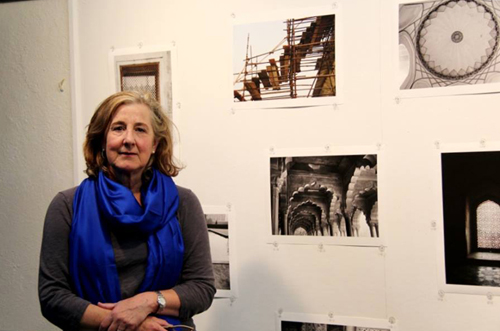
|
Sherry
Wiggins
USA
27th October 2014 – 19th November 2014
“In the project ‘Nasreen and I in Delhi’, I am engaging
with the art making processes of 21- century abstract Indian artist
Nasreen Mohamedi (1937-1990), by making my own 20 drawings and photographs
and blog in dialogue with her body of work. |
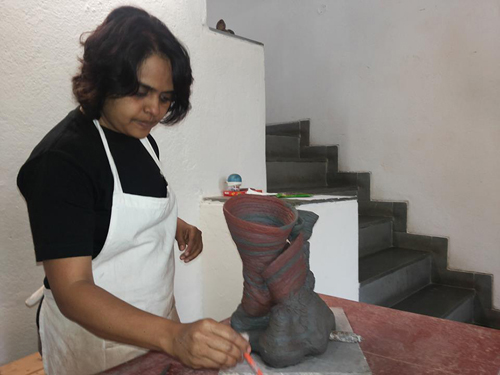
|
Madhavi
Kolte
India
7th Feb. - 27th Feb. 2015
Madhavi is a self taught artist and a teacher and believes that all
her thoughts as an artist are expressed through clay. Her work is best
expressed in coiling technique creating sculptures. She is inspired
by nature and creates a bridge between man and environment through her
art. Her project “Melt Down” revolves around the recent
landslides and human toll and natural calamities. Her work was exhibited
in the Open House and she donated one of her works created during the
residency to Sanskriti. |

|
Anindita
Dutta
Helpman Academy Artists
Australia
17th October 2014 – 30th November 2014
Aninditta Dutta's art practice combines sculpture, performance, and
installation as a way to express her thoughts. During her stay at Sanskriti
she worked on her project/exhibition "Everything Ends and Every
Thing Matters".
|
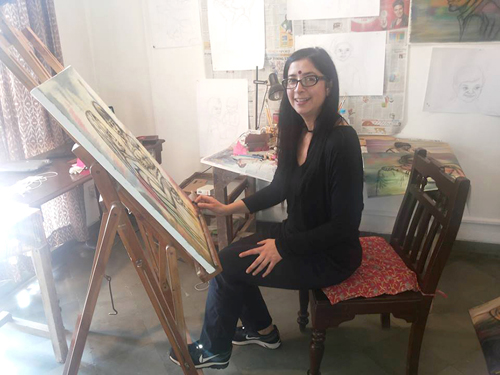
|
Veronica
Guzman
Mexico
16th Feb. - 14th March 2015
Her project was titled “Flavor of Indian Culture” for which
she has been touring India and photographing people from all walks of
life. During the residency she did a series of portraits in oil on canvas
capturing people from different walks of life which she exhibited at
the Open House. Her trip to Pushkar triggered her desire to explore
other parts of India as she was fascinated with the warmth, colours,
clothing and the camel fair. Varanasi and Jaipur added further depth
to her work as she could get a chance to interact with the local population.
|
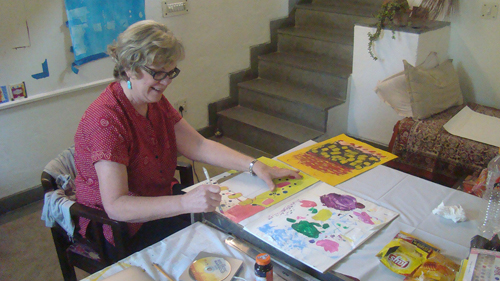
|
Susan
Cheal
Helpman Academy Artists
Australia
17th October 2014 – 30th November 2014
Susan was interested in the techniques of traditional Indian dyeing,
textiles design, block printing and produced a body of work that reflected
this gained knowledge which will form a part of the solo show she intends
to do in Dallas, Texas. While at Sanskriti, she created a body of work
on paper along with an outdoor installation inspired by the indigenous
techniques. |

|
Ismene
King
Greece
1st Feb. - 15th March 2015
Her project involves research and application of traditional textile
making techniques with focus on natural dyeing using local plant species
(resist dyeing, tie and dye and stitch resist etc.). She was provided
links for various natural products used as dyes traditionally in India.
She made use of natural dyeing in the creating of a large scale site
specific installation based on the technical knowledge acquired during
the residency and as a reflection of her experience of India and living
in Delhi. She participated in the indigo dyeing workshop conducted by
Yoshiko Wada from Japan which was a good learning experience for her.
|

|
Tracy
Featherstone
Miami University Group - USA |

|
Denise
Burge
Miami University Group - USA |
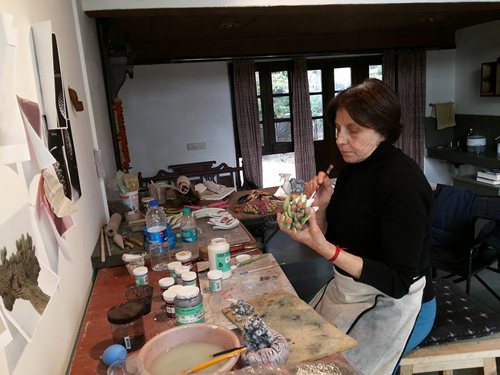
|
Diane
Kempler
USA
1st Jan. - 10th Feb. 2015
Diane created a series of painted ceramic hands and forms during the
period of her residency at Sanskriti. Her inspiration came from “Seeds”
both land and sea plant species including microscopic organisms. Her
style was unique involving painting the fired sculptures and mounting
them on the wall which gave them a feel of living organisms. Her body
of works shall be shown back home in the US. |
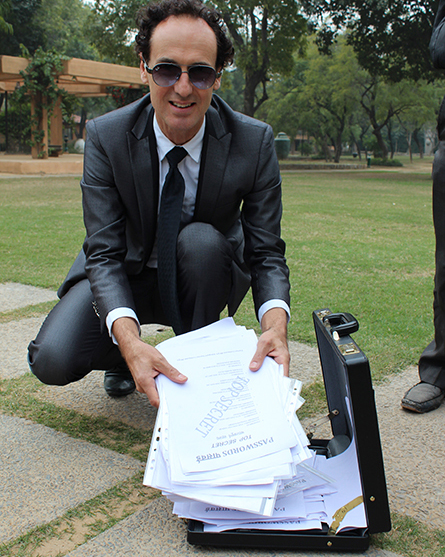
|
Peter
Burke
USA
During the residency in New Delhi, Peter created a video work which
explores his interest in the way acts of human kindness on the street
can be animated and captured on film. He performs humorous actions on
the street, such as dropping a briefcase, which will encourage audiences
to participate. He gets videos filmed by a professional videographer
in specific locations in commercial precincts where he is able to engage
with the public on the street. The project explores his interest in
the ways artists can creatively interrupt patterns of human behavior
and highlight the way urban spaces are used and the way humans interact.
|